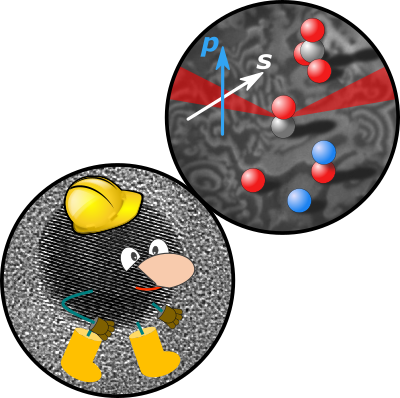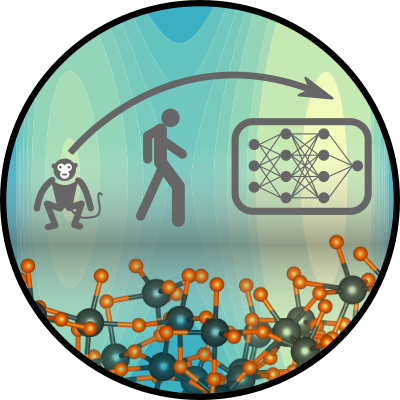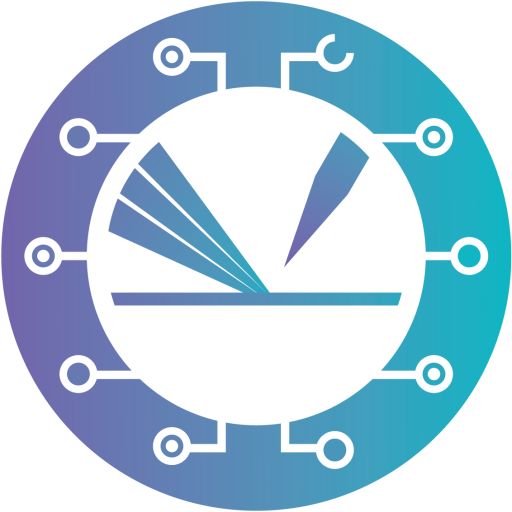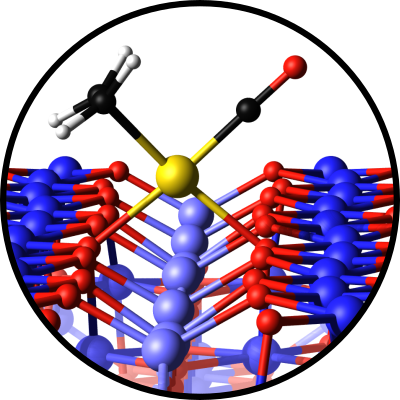Atomic-scale studies of catalysis
by spinel oxides
Subproject P04
The spinel class of metal oxides hosts diverse materials, some of which make excellent catalysts. Fe3O4 is already the industrial catalyst for the high-temperature water-gas shift reaction (CO+H2O -> H2+CO2), but research is needed to identify the optimal replacement for the toxic Cr promoter/stabilizer. Ternary MeFe2O4 compounds (Me=Fe, Ni, Co, Mn) are active and stable for the electrochemical oxygen evolution reaction (OER). However, the structure of the active catalyst and the reaction mechanisms are unknown. While these reactions appear different, both clearly benefit from a combination of multivalent cations in the surface layers.
In this project, we will seek to learn why, using a combination of atomic-scale imaging, a host of spectroscopies, and theory. We will dope the Fe3O4(001) surface with 3d transition metals and investigate how the adsorption energies, XPS binding energies, and IRAS frequencies of H2O, CO, CO2, O2, and H2 change with sample composition all the way from isolated dopants to ternary thin films. We will use the data obtained in tightly-controlled UHV experiments to:
i) Interpret the reactivity of our model catalysts under realistic HTWGS and OER conditions.
ii) Provide the benchmark data for experiments on nominally similar powder catalysts (P10 Föttinger).
iii) Support the development of theoretical modeling (P07 Franchini).
A joint postdoc (P04-P11) will facilitate the new collaboration with P11 Backus.
Expertise
- Scanning Tunneling Microscopy (STM) (in UHV 4K – 300 K, electrochemical STM)
- Atomic Force Microscopy (AFM): UHV-based (q+ sensor) and in the ambient (cantilever-based)
- Low-Energy Electron Diffraction (LEED)
- Reflection High Energy Diffraction (RHEED)
- X-ray Photoelectron Spectroscopy (XPS)
- Ultraviolet Photoelectron Spectroscopy (UPS)
- Auger Electron Spectroscopy (AES)
- Low-energy He+ ion scattering (LEIS)
- Thermal Programmed Desorption Spectroscopy (TPD)
Team

Associates
Publications
2016

Wolfbeisser, Astrid; Sophiphun, Onsulang; Bernardi, Johannes; Wittayakun, Jatuporn; Föttinger, Karin; Rupprechter, Günther
Methane dry reforming over ceria-zirconia supported Ni catalysts
Journal ArticleOpen AccessIn: Catalysis Today, vol. 277, pp. 234–245, 2016.
Abstract | Links | BibTeX | Tags: P08, P10, pre-TACO
@article{Wolfbeisser2016,
title = {Methane dry reforming over ceria-zirconia supported Ni catalysts},
author = {Astrid Wolfbeisser and Onsulang Sophiphun and Johannes Bernardi and Jatuporn Wittayakun and Karin Föttinger and Günther Rupprechter},
doi = {10.1016/j.cattod.2016.04.025},
year = {2016},
date = {2016-11-15},
urldate = {2016-11-15},
journal = {Catalysis Today},
volume = {277},
pages = {234--245},
publisher = {Elsevier BV},
abstract = {Nickel nanoparticles supported on Ce_{1-x}Zr_{x}O_{2} mixed oxides prepared by different synthesis methods, as well as Ni-ZrO_{2} and Ni-CeO_{2}, were evaluated for their catalytic performance in methane dry reforming (MDR). MDR is an interesting model reaction to evaluate the reactivity and surface chemistry of mixed oxides. Textural and structural properties were studied by N_{2} adsorption and XRD. Mixed oxide preparation by co-precipitation resulted in catalysts with higher surface area than that of pure ZrO_{2} or CeO_{2}. XRD analysis showed the formation of different Ce_{1-x}Zr_{x}O_{2} solid solutions depending on using a surfactant or not. The catalyst prepared by surfactant assisted co-precipitation was not active for methane dry reforming most likely because of the encapsulation of Ni particles by ceria-zirconia particles, as revealed by TEM and H_{2} chemisorption. The catalytic activity of the catalyst prepared by co-precipitation without surfactant was comparable to Ni-ZrO_{2}. Clearly, catalyst activity strongly depends on preparation and on the resulting phase composition rather than on nominal composition. Compared to Ni-ZrO_{2} the ceria-zirconia supported Ni catalyst did not achieve higher activity or stability for methane dry reforming but, nevertheless, the formation of filamentous carbon was strongly reduced (100 times less carbonaceous species). Consequently, using ceria-zirconia as a support material decreases the risk of reactor tube blocking.},
keywords = {P08, P10, pre-TACO},
pubstate = {published},
tppubtype = {article}
}

van Roekeghem, Ambroise; Carrete, Jesús; Oses, Corey; Curtarolo, Stefano; Mingo, Natalio
Journal ArticleOpen AccessIn: Physical Review X, vol. 6, no. 4, pp. 041061, 2016.
Abstract | Links | BibTeX | Tags: P09, pre-TACO
@article{Roekeghem2016,
title = {High-Throughput Computation of Thermal Conductivity of High-Temperature Solid Phases: The Case of Oxide and Fluoride Perovskites},
author = {Ambroise van Roekeghem and Jesús Carrete and Corey Oses and Stefano Curtarolo and Natalio Mingo},
doi = {10.1103/physrevx.6.041061},
year = {2016},
date = {2016-06-13},
urldate = {2016-06-13},
journal = {Physical Review X},
volume = {6},
number = {4},
pages = {041061},
publisher = {American Physical Society (APS)},
abstract = {Using finite-temperature phonon calculations and machine-learning methods, we assess the mechanical stability of about 400 semiconducting oxides and fluorides with cubic perovskite structures at 0, 300, and 1000 K. We find 92 mechanically stable compounds at high temperatures—including 36 not mentioned in the literature so far—for which we calculate the thermal conductivity. We show that the thermal conductivity is generally smaller in fluorides than in oxides, largely due to a lower ionic charge, and describe simple structural descriptors that are correlated with its magnitude. Furthermore, we show that the thermal conductivities of most cubic perovskites decrease more slowly than the usual T^{−1} behavior. Within this set, we also screen for materials exhibiting negative thermal expansion. Finally, we describe a strategy to accelerate the discovery of mechanically stable compounds at high temperatures.},
keywords = {P09, pre-TACO},
pubstate = {published},
tppubtype = {article}
}
2014

Föttinger, Karin; Rupprechter, Günther
Journal ArticleIn: Accounts of Chemical Research, vol. 47, no. 10, pp. 3071–3079, 2014.
Abstract | Links | BibTeX | Tags: P08, P10, pre-TACO
@article{Foettinger2014,
title = {In Situ Spectroscopy of Complex Surface Reactions on Supported Pd–Zn, Pd–Ga, and Pd(Pt)–Cu Nanoparticles},
author = {Karin Föttinger and Günther Rupprechter},
doi = {10.1021/ar500220v},
year = {2014},
date = {2014-09-23},
journal = {Accounts of Chemical Research},
volume = {47},
number = {10},
pages = {3071--3079},
publisher = {American Chemical Society (ACS)},
abstract = {It is well accepted that catalytically active surfaces frequently adapt to the reaction environment (gas composition, temperature) and that relevant “active phases” may only be created and observed during the ongoing reaction. Clearly, this requires the application of in situ spectroscopy to monitor catalysts at work. While changes in structure and composition may already occur for monometallic single crystal surfaces, such changes are typically more severe for oxide supported nanoparticles, in particular when they are composed of two metals. The metals may form ordered intermetallic compounds (e.g. PdZn on ZnO, Pd_{2}Ga on Ga_{2}O_{3}) or disordered substitutional alloys (e.g. PdCu, PtCu on hydrotalcite). We discuss the formation and stability of bimetallic nanoparticles, focusing on the effect of atomic and electronic structure on catalytic selectivity for methanol steam reforming (MSR) and hydrodechlorination of trichloroethylene. Emphasis is placed on the in situ characterization of functioning catalysts, mainly by (polarization modulated) infrared spectroscopy, ambient pressure X-ray photoelectron spectroscopy, X-ray absorption near edge structure, and X-ray diffraction. In the present contribution, we pursue a two-fold, fundamental and applied, approach investigating technologically applied catalysts as well as model catalysts, which provides comprehensive and complementary information of the relevant surface processes at the atomic or molecular level. Comparison to results of theoretical simulations yields further insight.
Several key aspects were identified that control the nanoparticle functionality: (i) alloying (IMC formation) leads to site isolation of specific (e.g. Pd) atoms but also yields very specific electronic structure due to the (e.g. Zn or Ga or Cu) neighboring atoms; (i) for intermetallic PdZn, the thickness of the surface alloy, and its resulting valence band structure and corrugation, turned out to be critical for MSR selectivity; (ii) the limited stability of phases, such as Pd_{2}Ga under MSR conditions, also limits selectivity; (iii) favorably bimetallic catalysts act bifunctional, such as activating methanol AND water or decomposing trichlorothylene AND activating hydrogen; (iv) bifunctionality is achieved either by the two metals or by one metal and the metal–oxide interface; (v) intimate contact between the two interacting sites is required (that cannot be realized by two monometallic nanoparticles being just located close by).
The current studies illustrate how rather simple bimetallic nanoparticles may exhibit intriguing diversity and flexibility, exceeding by far the properties of the individual metals. It is also demonstrated how complex reactions can be elucidated with the help of in situ spectroscopy, in particular when complementary methods with varying surface sensitivity are applied.},
keywords = {P08, P10, pre-TACO},
pubstate = {published},
tppubtype = {article}
}
Several key aspects were identified that control the nanoparticle functionality: (i) alloying (IMC formation) leads to site isolation of specific (e.g. Pd) atoms but also yields very specific electronic structure due to the (e.g. Zn or Ga or Cu) neighboring atoms; (i) for intermetallic PdZn, the thickness of the surface alloy, and its resulting valence band structure and corrugation, turned out to be critical for MSR selectivity; (ii) the limited stability of phases, such as Pd2Ga under MSR conditions, also limits selectivity; (iii) favorably bimetallic catalysts act bifunctional, such as activating methanol AND water or decomposing trichlorothylene AND activating hydrogen; (iv) bifunctionality is achieved either by the two metals or by one metal and the metal–oxide interface; (v) intimate contact between the two interacting sites is required (that cannot be realized by two monometallic nanoparticles being just located close by).
The current studies illustrate how rather simple bimetallic nanoparticles may exhibit intriguing diversity and flexibility, exceeding by far the properties of the individual metals. It is also demonstrated how complex reactions can be elucidated with the help of in situ spectroscopy, in particular when complementary methods with varying surface sensitivity are applied.






